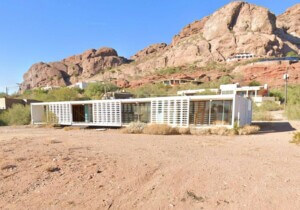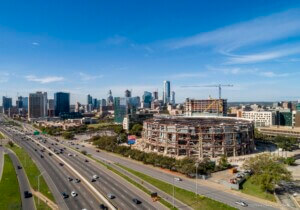“It was a peculiar and visionary time, those years after World War II to which all the Malls and Towns and Dales stood as climate-controlled monuments,” Joan Didion wrote in her iconic 1979 treatise on Californian culture, The White Album. “The frontier had been reinvented… that new free land on which all settlers could recast their lives tabula rasa.”
Didion romantically reflected on the rituals of the freeway, the immediate gratification of the rising strip mall, as well as the architects who built them who she claimed: “Staked the past to seize the future.” Today, few typologies more accurately represent the promises and shortcomings of suburban life, its perils made clear as towns across America continue to witness the “death” of their local shopping mall. The demolition of Scottsdale, Arizona‘s oldest strip mall, Papago Plaza, and its replacement with a massive, mixed-use redevelopment, shows that this death is perhaps more akin to an evolution.
Vacant for years, demolition of the pink stucco strip began December 5, where Lee Mashburn of Pivot Development spoke at a ceremony that marked the beginning of the next phase of the site. “We’re not developing a strip center,” he said at the groundbreaking according to a local news network, “we’re developing a sense of place and I’m proud of that.”
Down it goes. pic.twitter.com/4enkMmOUEQ
— Josh Frigerio, ABC15 (@JoshFrigerio) December 5, 2019
The adobe-style landmark, Papago Plaza, was built in 1962 and originally named Frontier Town Plaza. In an attempt to stay true to regional architectural heritage, the plaza changed its name while simultaneously undergoing a Pueblo-revival style renovation in 1988. The term, Papago, is now an obsolete name given to the indigenous Tohono O’odham people by Spanish colonizers—it has since been rejected by the tribe. The redevelopment will keep the name in remembrance of the original strip. “Keeping the name was important to tell the legacy of the project. You gotta respect that. It’s been here for 60 years,” said Mashburn.
The $100 million redevelopment will consist of a 118-room Marriott hotel, more than 270 apartments developed by Alliance Residential, restaurants, retail, and an Aldi grocery store. It would be a stretch to call it adaptive reuse, though some have, but the developers plan to repurpose a few of the strip’s elements such as the kachina on the sign and the original wood beams. The new center will also feature murals, gathering areas for events, and a park with a water feature. Construction of the first phase retail center is expected to be completed in the fall of 2020. The hotel, apartments, and grocery store will follow.
Aesthetically, the redesign couldn’t be any different from the original mall, as the ethos of the American roadside establishment has faded—exchanging parking lots for 120,000 square foot garages, novelty gift shops for accessible green space, and suburbs for multi-level apartment buildings. And while it is certainly emblematic of good ole’ Americana, some residents could care less about the strip’s demise. Local journalist Peter Corbett tweeted, “Good riddance to Papago Plaza. It’s a stretch to call it iconic… the architecture was a mashup of Flintstone’s Bedrock City and faux Pueblo style.”
But as Didion said, when it comes to the retail experience, frontiers will continue to be reinvented, sometimes at the expense of history and sometimes at the expense of pure nostalgia.
See below for a video tour of the historic Papago Plaza before demolition:











